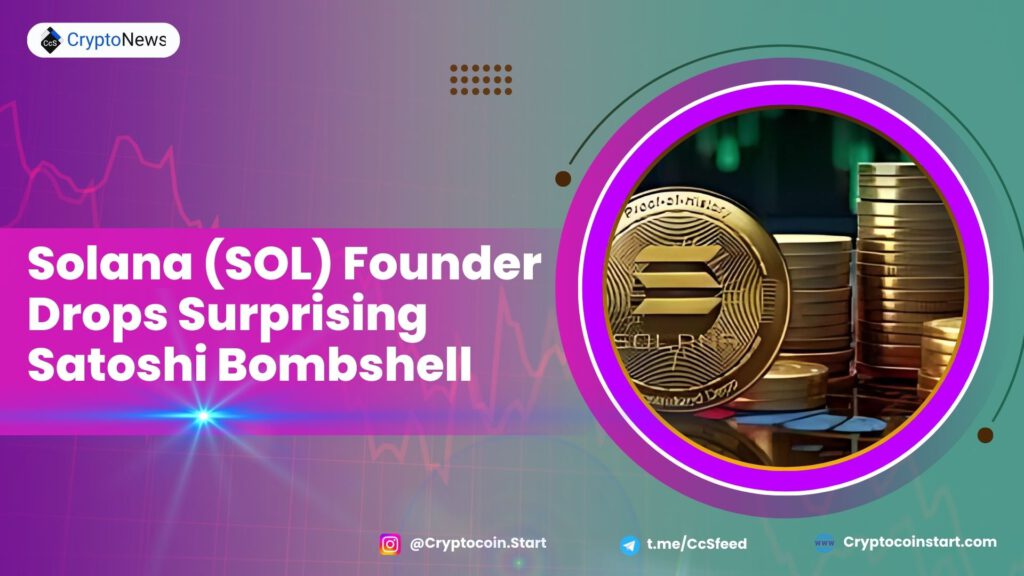
Yakovenko’s Mysterious Tweet
On September 15, 2024, Anatoly Yakovenko took to Twitter to make a bold and somewhat playful assertion about Solana’s connection to Bitcoin. He stated:
“Solana is a Bitcoin L2 endorsed but not backed by Satoshi. She just did a much better job covering her tracks this time around.”
This tweet sparked widespread speculation about the possible meaning behind his words. Could Yakovenko be hinting at a deeper connection between Solana and Bitcoin? Or was this simply a tongue-in-cheek reference to the shared principles of decentralization and scalability that both blockchains embody?
Solana: Designed for Scalability and Censorship Resistance
While the statement made by Yakovenko is intriguing, it’s essential to understand the core architecture of Solana. Solana (SOL) is an independent Layer-1 blockchain designed to address issues of scalability and censorship resistance. Launched in March 2020, Solana’s architecture allows it to handle an exceptionally high throughput of transactions, all at significantly lower costs compared to other major blockchains such as Bitcoin or Ethereum.
Yakovenko initially proposed Solana in 2017, long after Satoshi Nakamoto vanished from the public eye in 2011. Using its unique Proof-of-History (PoH) consensus mechanism, Solana can efficiently sequence transactions, setting it apart from Bitcoin’s Proof-of-Work (PoW) model.
Is Solana a Bitcoin Layer 2?
Layer 2 (L2) solutions are designed to enhance the scalability and performance of a Layer-1 blockchain, typically by offloading certain processes to a secondary network. Despite Yakovenko’s playful suggestion, Solana is not technically a Bitcoin L2. It operates as a separate, Layer-1 blockchain with its distinct consensus mechanism and infrastructure.
However, Yakovenko’s reference might suggest that Solana draws inspiration from Bitcoin’s decentralized ethos. Solana shares certain similarities with Bitcoin in its vision for scalability and resistance to censorship, but the two operate on entirely different technological foundations.
Previous References to Satoshi and Bitcoin
This isn’t the first time Yakovenko has linked Solana to Bitcoin and Satoshi Nakamoto. Earlier in 2024, after the release of a series of email conversations between Satoshi and Martti Malmi (one of Bitcoin’s early developers), Yakovenko made a similar statement. In response to parts of the emails that highlighted Bitcoin’s decentralization principles, Yakovenko commented:
“Satoshi also invented Solana. She just did a much better job covering up her tracks this time. The truth is out there.”
These statements are likely meant to highlight Solana’s alignment with Bitcoin’s overarching goals—creating a decentralized, secure, and scalable blockchain network. While tongue-in-cheek, Yakovenko’s comments may be hinting at how Solana builds on some of the same values that Bitcoin was founded upon, but with a modern twist.
How Solana Differentiates Itself from Bitcoin
Despite the playful nods to Bitcoin, Solana’s technical structure is vastly different from that of Bitcoin. Here are some key differences:
- Consensus Mechanism: Bitcoin uses Proof-of-Work (PoW), requiring miners to solve complex puzzles to validate transactions. Solana, on the other hand, uses Proof-of-History (PoH), a system that timestamps transactions, allowing for faster and more efficient processing.
- Transaction Speed: Bitcoin can process roughly 7 transactions per second (TPS), whereas Solana boasts a capacity of over 65,000 TPS, making it one of the fastest blockchains in the world.
- Energy Efficiency: Solana’s consensus mechanism is significantly more energy-efficient than Bitcoin’s PoW model, which is known for its heavy energy consumption.
- Cost: Transaction fees on Solana are a fraction of those on Bitcoin, making it more accessible for everyday users and decentralized applications (dApps).
Market Performance of SOL
At the time of writing, Solana’s native cryptocurrency SOL has experienced a slight decline, trading at $136 after a 0.25% drop over the last 24 hours. Despite this, Solana continues to be one of the most prominent players in the blockchain space, gaining widespread adoption across decentralized finance (DeFi), non-fungible tokens (NFTs), and other sectors.
Yakovenko’s playful remarks have certainly stirred interest, but Solana’s strength lies in its cutting-edge technology and ability to scale in ways that few other blockchains can. Whether or not there’s any deeper meaning behind the reference to Satoshi remains to be seen, but Solana’s growing ecosystem speaks for itself.
Conclusion: A Playful Comparison or a Deeper Connection?
Anatoly Yakovenko’s mention of Solana as a “Bitcoin L2 endorsed but not backed by Satoshi” is likely more playful than literal. Solana is a powerful, independent Layer-1 blockchain that stands on its own merits, with no direct ties to Bitcoin or its enigmatic creator.
However, the comparison serves as a reminder of the shared goals that many blockchain projects strive for: decentralization, scalability, and security. While Solana and Bitcoin differ in their technologies, both seek to push the boundaries of what is possible in the blockchain world.

